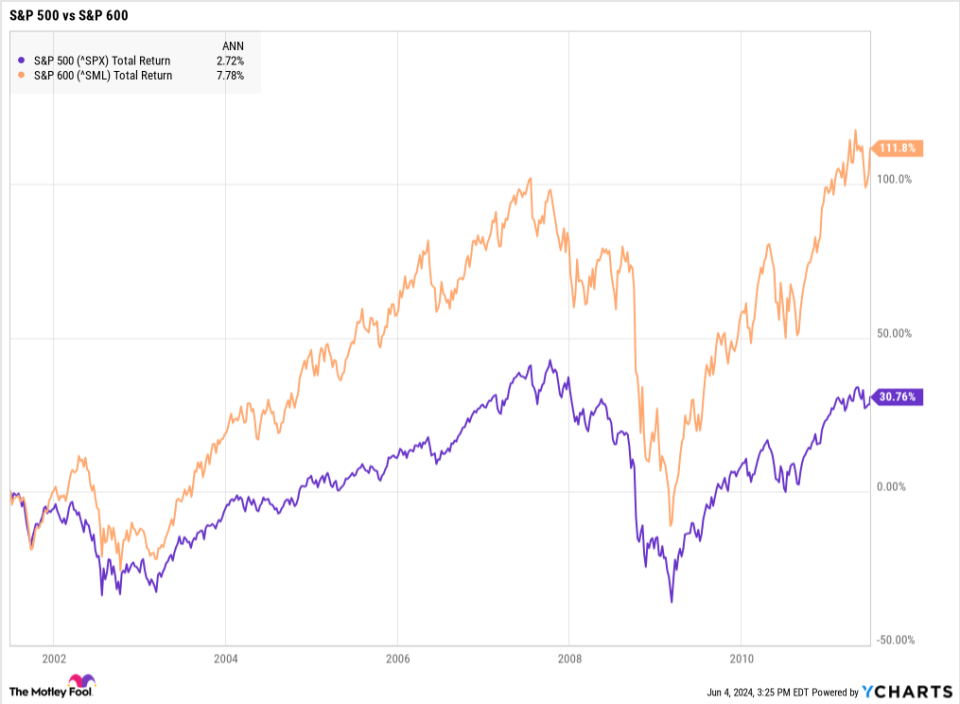Consistently investing in the stock market is a proven wealth creator. Over the long term, stocks produce better returns than almost any other asset class.
While stocks as a group consistently climb in value over time, economic cycles lead some segments to outperfom others when you zoom in on a few years at a time. Over the last few years, big tech stocks have powered the overall stock market higher. Most recently, artificial intelligence (AI) has fueled a huge surge in pricing for some of the biggest tech companies in the world.
But the cycle could be about to shift. One indicator suggests a certain segment of the market is historically undervalued, and it could be a great opportunity for investors.
The huge valuation gap in today’s stock market
The metric investors need to pay attention to is the gap in the forward price-to-earning (P/E) ratios of the S&P 500 index and the S&P 600 index. The S&P 500 tracks about 500 of the largest companies in the United States that have been consistently profitable. The S&P 600 is its small-company counterpart.
As of the start of June, the aggregate forward P/E of the S&P 500 was 20.3 versus just 14.5 for the S&P 600. That’s a gap of 5.8 points. The gap has hovered around 6 points since the start of the year, reaching a level it hasn’t seen since mid-2001.
Small-cap stocks historically outperform large-cap stocks. And small-cap value stocks, which the S&P 600 tilts toward, have an even better track record. But the outperformance comes in fits and starts.
The last time the valuation gap between large caps and small caps was this wide, small caps handily outperformed large caps. The S&P 600 produced a total return of 69% in the five years from mid-2001 versus just 13.1% for the S&P 500 for that period. The indexes returned 111.8% and 30.8%, respectively, in the 10 years that followed mid-2001, which included the tail end of the dot-com bubble pop and the Great Recession. (The latter hit small caps just as hard as large caps.)
The reasons for the wide valuation gap
Regarding 2024’s market situation, there are several reasons we’re experiencing a historic valuation gap between large-cap stocks and small-cap stocks.
The large-cap index is currently heavily weighted toward just a few big tech stocks. The “Magnficent Seven,” which have driven stock market returns over the past 18 months, account for over 29% of the entire S&P 500. And those stocks have a much higher-than-average valuation.
The MegaCap-8, which includes the Magnificent Seven (Apple, Alphabet, Amazon, Meta Platforms, Microsoft, Nvidia, and Tesla) and Netflix, have a forward P/E of 28.9, according to Yardeni Research. The S&P 500 forward P/E ratio is 20.3, and if you remove the MegaCap-8, it’s just 18.3.
The heavy weighting of just a few big tech stocks is reminiscent of the market in 2000 at the height of the dot-com bubble. While valuations aren’t nearly as high as they were back then, it does strengthen the idea that big tech could take a breather while small-cap stocks take the lead over the next few years.

That said, there are reasons small caps have been beaten down lately. The S&P 600 forward P/E of 14.5 is on the lower end of its historical average.
One big reason for small caps’ lower valuation is the impact of interest rates on their businesses and the overall market. Small caps generally have more floating interest rates versus long-term bonds. So, as interest rates climbed, small companies felt more pain from higher interest expenses.
Adding to that challenge is that as bond yields improved, investors demanded a greater risk-premium from small-cap stocks, which put pressure on prices.
However, the tide appears to be turning for small caps. Investors expect the Fed to lower interest rates starting this year and continuing into next year. Meanwhile, the rapid AI-fueled growth of big tech is bound to come down to earth. That bodes well for small caps to outperform the large-cap index over the next few years.
How to invest in today’s market
There are several ways to add small-cap stocks to your portfolio. You could research individual companies to try to find the best publicly traded small caps. These companies aren’t as widely followed, which means there could be a great opportunity to outperform.
But even the professionals struggle to beat the index consistently. Less than 12% of active small-cap mutual funds outperformed the S&P 600 over the past 10 years after accounting for fees.
That’s why one of the best ways to invest in small caps is to use an index fund. You could buy an S&P 600 index fund like the SPDR S&P 600 Small Cap ETF (NYSEMKT: SPSM). It simply tracks the S&P 600 and charges a minuscule expense ratio of 0.03%.
If you want a broader index for small caps, you could use the Russell 2000. Unlike the S&P 600, there’s no profitability requirement for the index. It simply follows the smallest 2,000 companies in the broader Russell 3000 index, which aims to track the overall market. As a result, there are also some mid-cap stocks and more growth stocks.
That said, the S&P 600 has historically outperformed the Russell 2000. Nonetheless, the Vanguard Russell 2000 ETF (NASDAQ: VTWO) is a great option with a low expense ratio.
Among small-cap stocks, value stocks have outperformed the rest of the group over long periods. While the S&P 600 tilts toward value stocks, you could get more concentrated exposure to the factor by investing in an ETF specifically focused on small-cap value stocks. The Avantis U.S. Small Cap Value ETF (NYSEMKT: AVUV) uses profitability and valuation criteria to select a broad portfolio of small-cap value stocks aimed at outperforming the Russell 2000 Value index.
Any of the above are great options in today’s market. And while it might take time for the tides to turn on small caps, all indications are that the segment is poised to outperform over the next few years.
Should you invest $1,000 in SPDR Series Trust – SPDR Portfolio S&P 600 Small Cap ETF right now?
Before you buy stock in SPDR Series Trust – SPDR Portfolio S&P 600 Small Cap ETF, consider this:
The Motley Fool Stock Advisor analyst team just identified what they believe are the 10 best stocks for investors to buy now… and SPDR Series Trust – SPDR Portfolio S&P 600 Small Cap ETF wasn’t one of them. The 10 stocks that made the cut could produce monster returns in the coming years.
Consider when Nvidia made this list on April 15, 2005… if you invested $1,000 at the time of our recommendation, you’d have $741,362!*
Stock Advisor provides investors with an easy-to-follow blueprint for success, including guidance on building a portfolio, regular updates from analysts, and two new stock picks each month. The Stock Advisor service has more than quadrupled the return of S&P 500 since 2002*.
*Stock Advisor returns as of June 3, 2024
Suzanne Frey, an executive at Alphabet, is a member of The Motley Fool’s board of directors. John Mackey, former CEO of Whole Foods Market, an Amazon subsidiary, is a member of The Motley Fool’s board of directors. Randi Zuckerberg, a former director of market development and spokeswoman for Facebook and sister to Meta Platforms CEO Mark Zuckerberg, is a member of The Motley Fool’s board of directors. Adam Levy has positions in Alphabet, Amazon, American Century ETF Trust – Avantis U.S. Small Cap Value ETF, Apple, Meta Platforms, Microsoft, and Netflix. The Motley Fool has positions in and recommends Alphabet, Amazon, Apple, Meta Platforms, Microsoft, Netflix, Nvidia, and Tesla. The Motley Fool recommends the following options: long January 2026 $395 calls on Microsoft and short January 2026 $405 calls on Microsoft. The Motley Fool has a disclosure policy.
The Stock Market Is Doing Something It Hasn’t Done in 23 Years, and It Could Signal a Big Investment Opportunity was originally published by The Motley Fool
Signup bonus from





